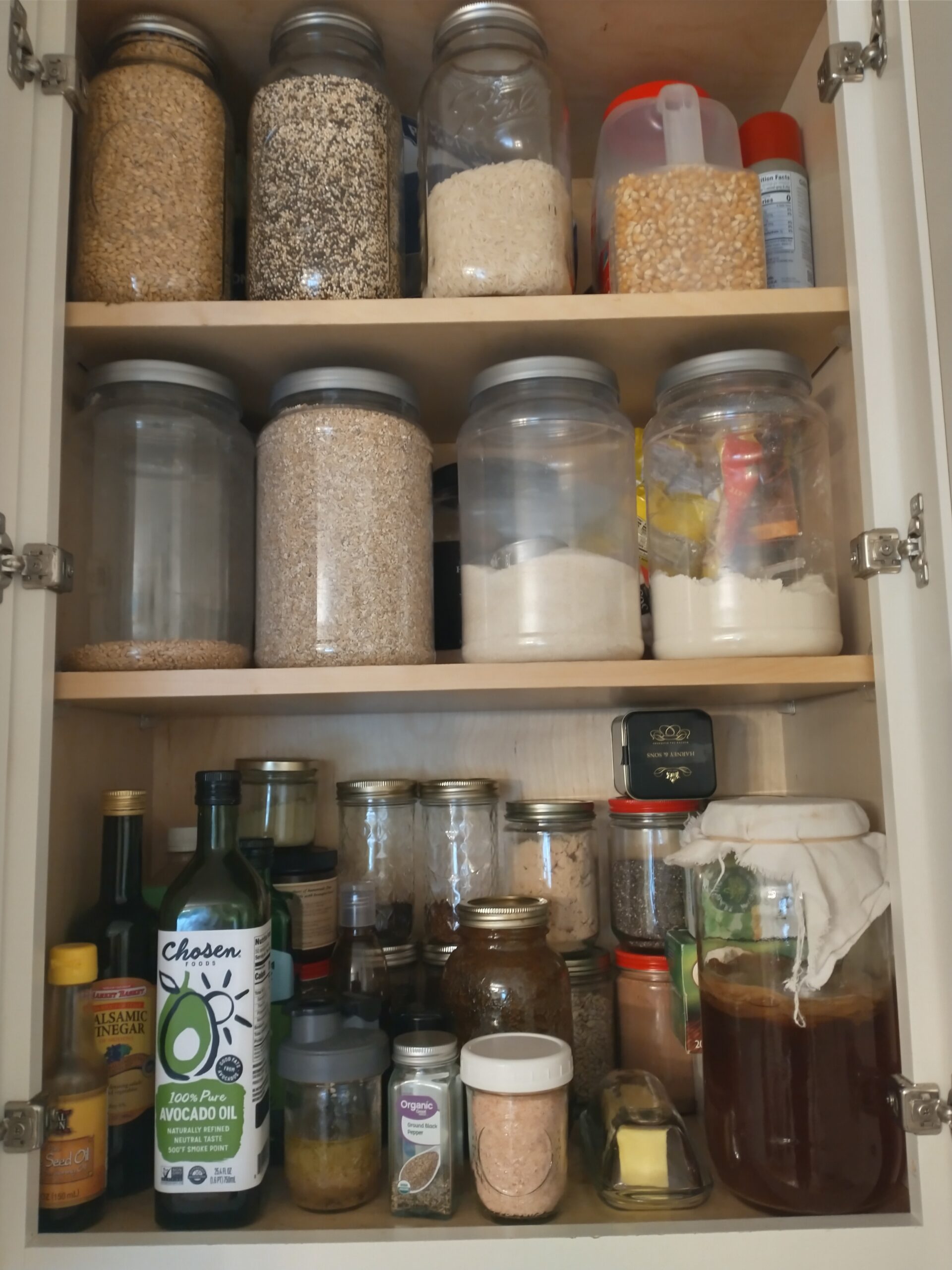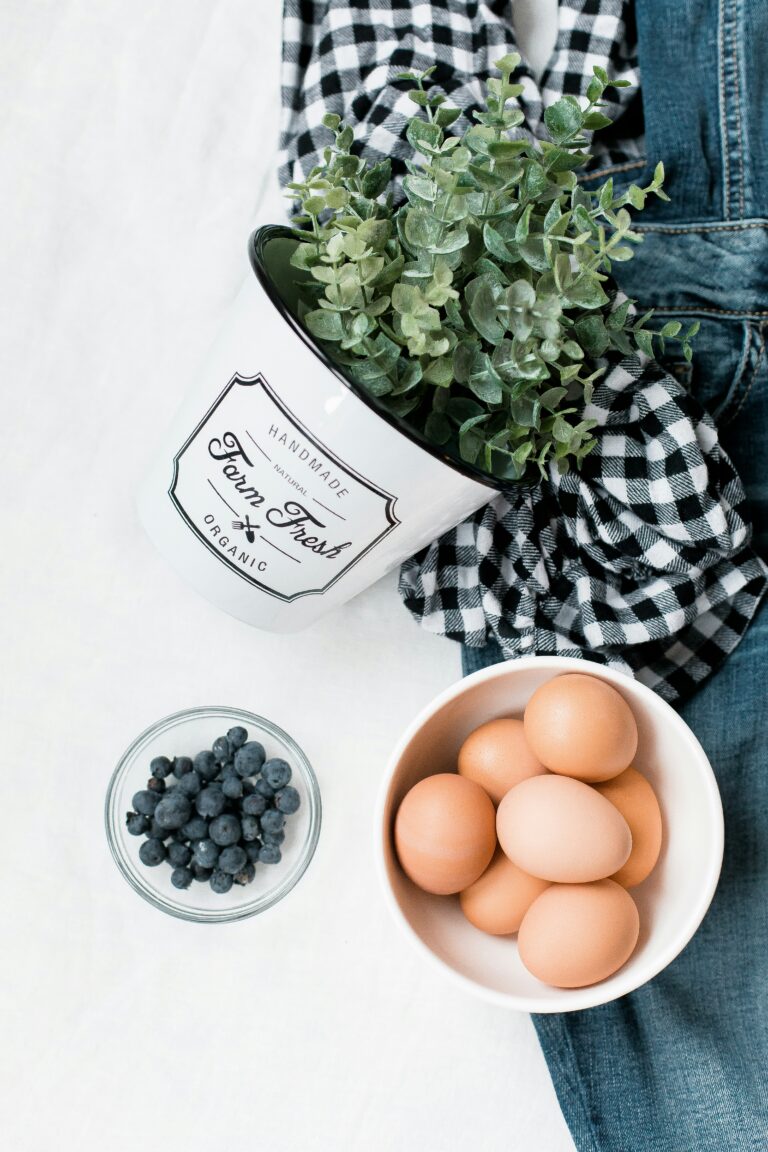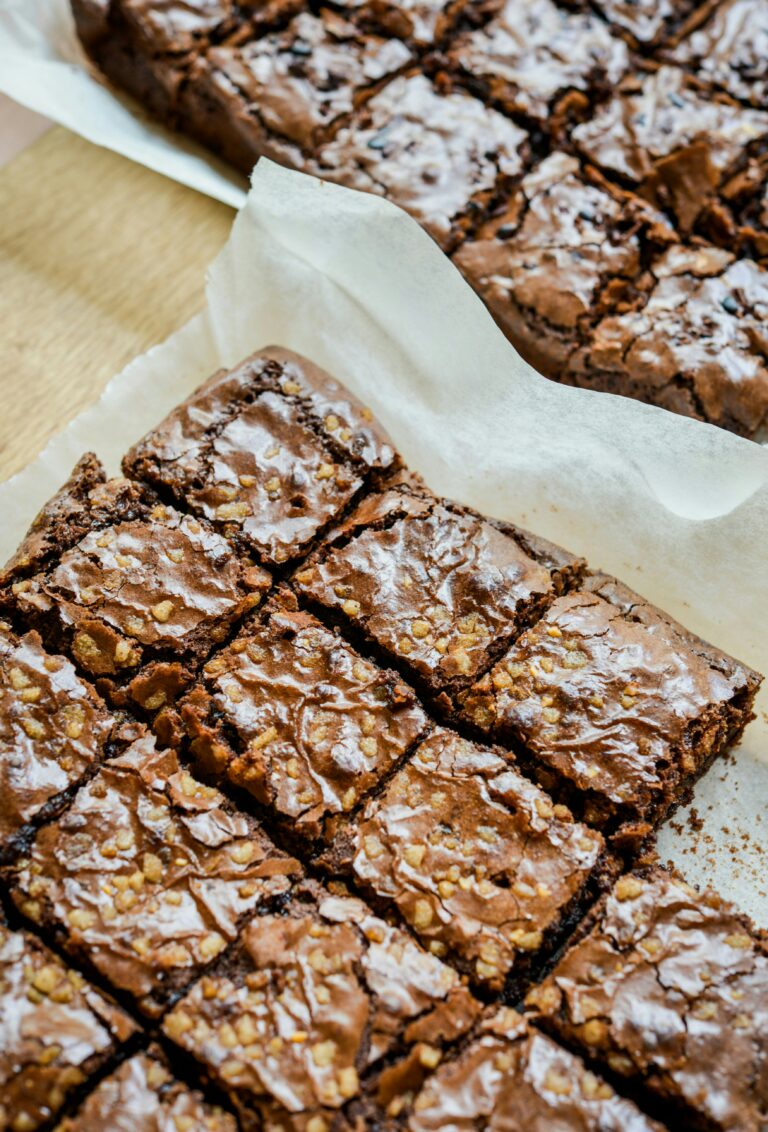how to create realistic kitchen organization without pricy containers
There is a way to create realistic kitchen organization without a multitude of expensive containers! You can create a result you can be proud of with little to no money. Keep reading to find out more!
Why realistic kitchen organization?
1. Efficiency
Streamlined, realistic kitchen organization, means you know where everything is and how much is left. Nothing is in the spot where it is usually, you know something needs to be repurchased. When a clear container is getting down to the bottom, you know you are running out. All with just a quick glance!
You avoid rebuying items when you already have them but couldn’t find them. Never again will you spend your precious time hunting around to find an ingredient while you’re cooking dinner. You know exactly where everything is.
When things have a place, and are very obviously “out”, this helps family members to be able to help cook, make their own snacks, put away groceries, or even order/put on the list things in the kitchen which are out.
Being efficient saves you a LOT of time, money, and unnecessary stress! Who couldn’t use less stress these days?
2. Peace of Mind
When you have realistic kitchen organization, you no longer spend time worrying about the kitchen and its basic functioning. You have peace of mind. Your mind can focus on other, less basic tasks that you want to do. Things function in an easy to maintain flow. Starting an at home business, spending more quality time with your family, or dialing in on other homemaking tasks you want to make more efficient.
3. Aesthetic
Let’s be real – a nice organizational system is SO relaxing to the mind to look at. It’s OK to have something you enjoy looking at and feel good about. This is about realistic kitchen organization – doing your best, and making the most of what you have.
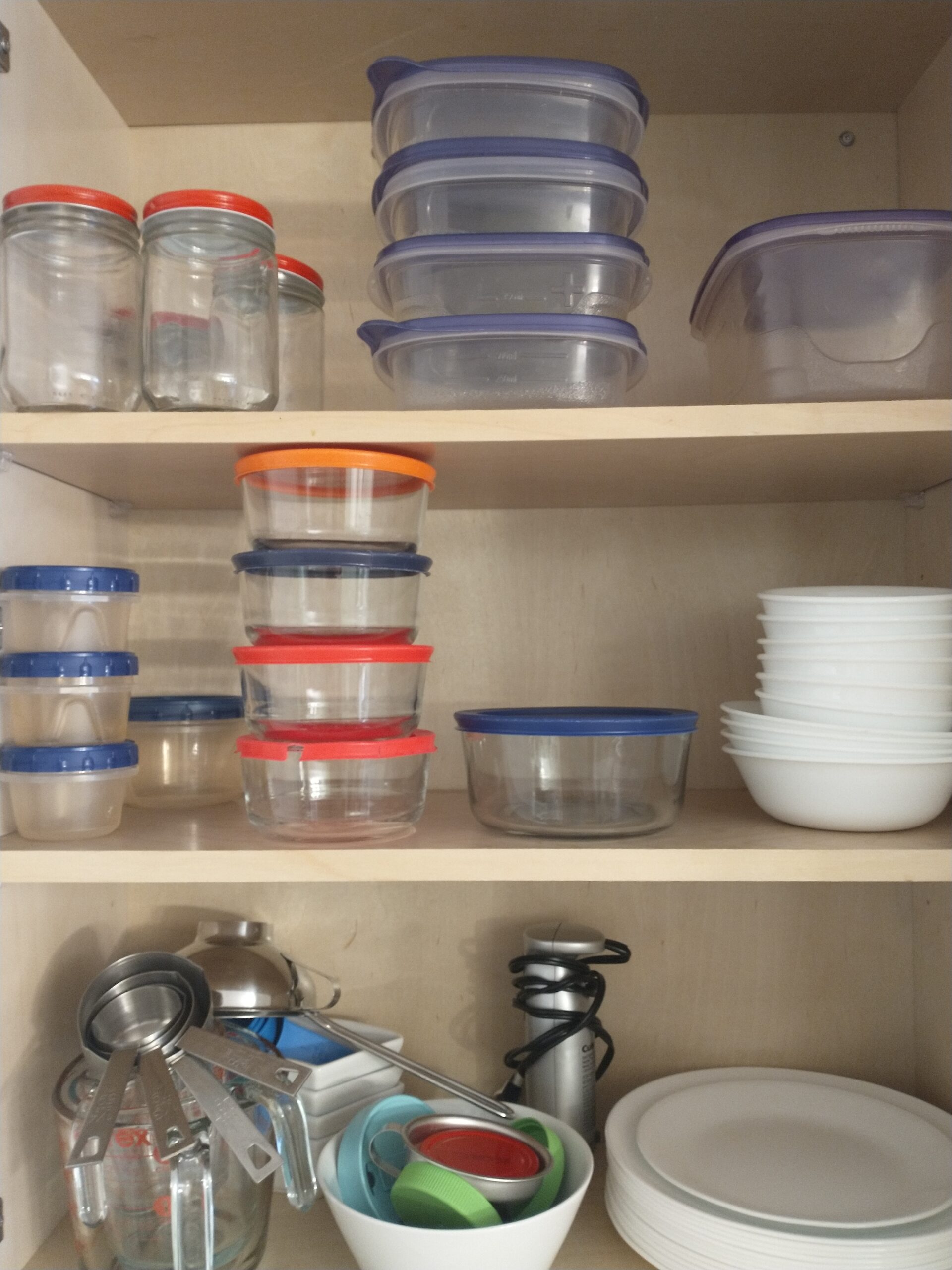
are lots of containers realistic kitchen organization?
I won’t lie, containers do serve a purpose and definitely create a beautiful aesthetic. But sometimes they don’t make the cut for realistic kitchen organization for a few reasons.
1. Agonizing over finding “the one”
There are A LOT of unique containers out there but sometimes the “perfect” one can’t be found for the space you are looking for. Or spending all the time looking for the right one can prove to not be the best use of your time, even halting the progress of the project so it doesn’t get done.
2. Financially
Unfortunately, social media and living standards have skewed our view of what is essential and non essential to have in our society. Everyone is at a different place financially and sometimes it is just not realistic kitchen organization to be spending a lot of money on non essential items.
If you are in debt or need to save for an upcoming big purchase, things like storage containers are probably not something that should be on your shopping list.
Items you, your friends, or your family purchase routinely may come in containers that you can reuse for your organization project. You can even find containers you already have around the house that can be repurposed, or find something at your local recycling center.
Spray paint can be your best friend for touching up the outside of lids or containers for storage to make them look nicer.
3. Not always practical
If you move a lot, having a lot of containers may make them unrealistic for repurposing in a different space. Try for a moderate amount, avoiding if possible, to ensure you aren’t packing up tons of containers when you move, only to have to donate them when you get to your new space and they don’t work anymore for a new space.
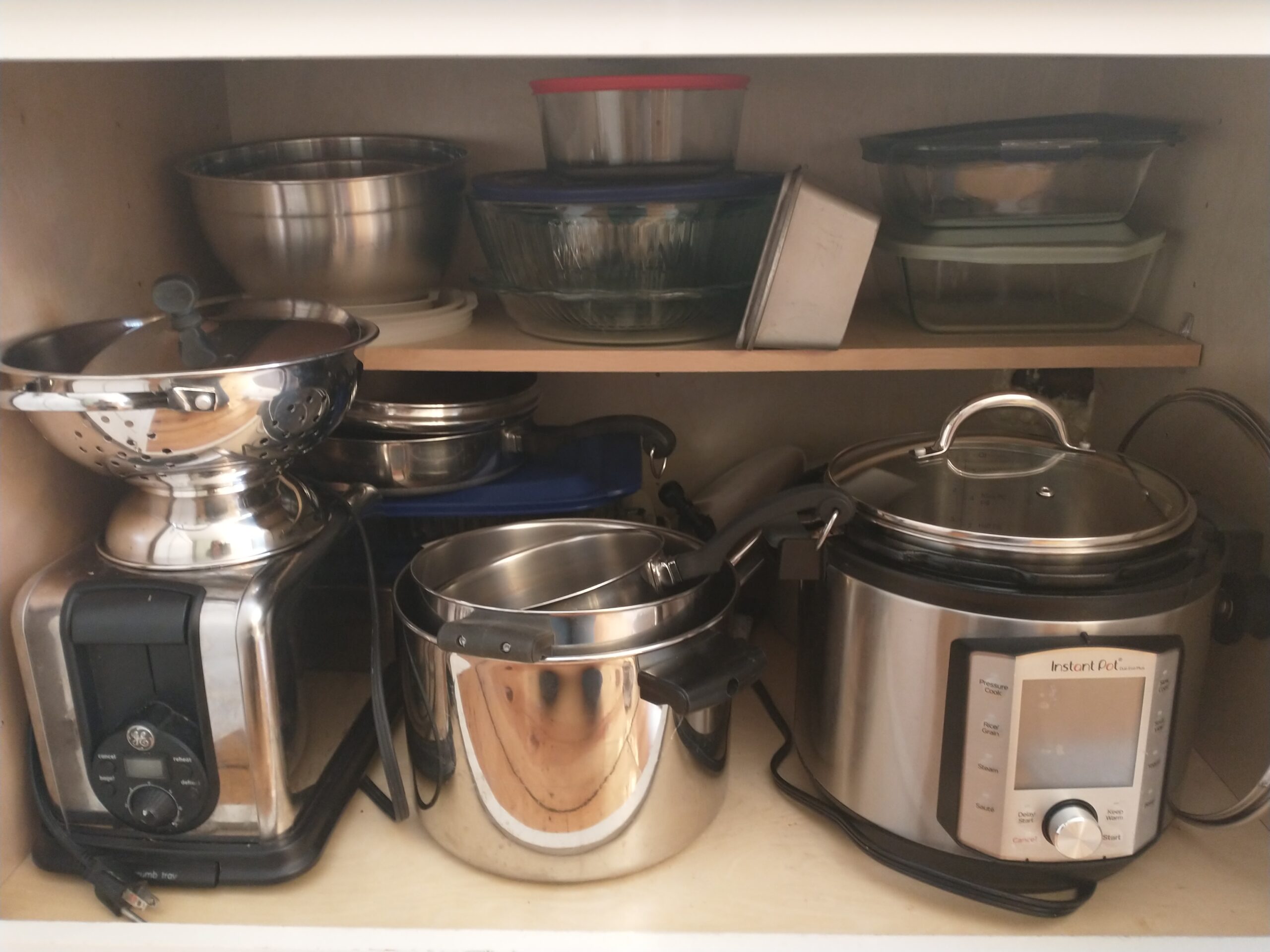
4 steps to Make a Realistic Kitchen Organization System
1. Determining what foods you actually like and meet your food standards
The goal here is to make a personalized “staple” list that you feel good about. This will be fluid at first as you are still determining which foods work best for your family. The items should fit the following criteria:
taste
I know it sounds ridiculous, but do you actually LIKE the food?
Sometimes we buy things and they just don’t taste great. Maybe we thought our family would eat it and they aren’t interested. Move these items to the front or place on the counter to prioritize eating now, and stop repurchasing. If they are just not going to be eaten, cut your loss and toss them or give them to someone else who will eat it.
worthy to be a staple?
I know it sounds crazy, but is this item a single tasker or something you are going to use regularly in multiple dishes and DESERVES some space in your kitchen organization?
Check out some of my favorites that i’ve isolated as pantry staples in my home. I also LOVE Budget Bytes, and when I learned to cook I used a lot of her basic guidelines for pantry staples. If you have no idea where to start with what types of vinegars or spices to keep on hand, check out her pantry staples list here.
Certain items have a lot of versatility and you can use in multiple ways as different ingredients. Having the right supplies on hand that you like can even encourage some culinary creativity which is always fun. Whipping up a homemade salad dressing, or a custom yogurt parfait can ensure you are always prepared with yummy options for anyone who’s hungry.
health
Does this food meet my guidelines for health? If you avoid added sugar, does this food have added sugar?
Make sure you take a look at the ingredients on the items you purchase and make sure they fit any health preferences or dietary guidelines you have. If they don’t, take some time to isolate one or try new products until you find “the one” you can feel good about and you can stop searching or buying random foods because you haven’t found the perfect item for your family.
Accessibility
If you have an ingredient you love, but you have to go to a specific grocery store to get it which is out of your way, or you can’t order it easily, maybe you need to reassess. If you aren’t in a season where shopping at multiple stores is reasonable, maybe you need to look around and see if you can find a “best fit” for where you are able to shop easily, even if it means paying a little bit more.
affordability
Alternatively, Is there a generic or a different store where you could purchase this item which saves money? Find the best fit and sticking to that one type will “automatically” save you money every time you buy it.
If it’s not your season to shop at multiple stores, and you have a few options for where you will shop, check the prices of your favorite staple ingredients. Figure out which store has most of your staples at a cheaper price.
2. Declutter
Strip down any excess non essential or unwanted furniture in your kitchen for food storage. Try to work with what you have as permanent storage (i.e., your cabinets) or be very choosy about what kind of storage furniture you allow. Is it actually functional and do you like it? Look for something within your budget that has ideal functionality if you absolutely need an additional storage piece. You can save on containers, but this is one area you may need to spend if you have a larger family or more food storage needs with very limited cabinet space.
Just keep in mind to eat good meals, you don’t need a myriad of different spices and ingredients. Even a few food options can be mixed and matched with different kinds of spices and side dishes to get a different meal every night of the month.
Declutter and eliminate any kitchen appliances you don’t like or use, and excess pots and pans you don’t need. You don’t need to keep so many pots and pans for fear one might be dirty. This will encourage you and your family to be doing dishes more regularly, preventing the big “back up” of dirty dishes. You can only use so many pots and pans as fit on your stove at one time! Larger or special occasion pots or pans may need to find a place elsewhere, if they are still deemed necessary.
Discard or donate any of those food items that are just not working for your family.
Time will tell bin
Any items that you aren’t sure you can live without, or don’t plan on using long term as intentional “pantry staples” place into a bin or box out of the kitchen area. Make a set amount of time to reassess if this is worthy item.
3. Determine location of items based on frequency of use and height
Now you need to figure out what makes sense “where” in your kitchen.
Dishes, glassware, silverware
These should usually be placed near the dishwasher for ease of unloading.
Spices and oils
These are most conveniently kept next to the stove.
Pantry staples that are an every day use should be placed convenient to your reach. Items that are back up stock like extra coffee, juice, or condiments that your in-use item is in the fridge can be kept in less convenient locations. Items for special occasions or not used regularly can be kept up higher, or even in another non-kitchen area.
Plastic items can be stored up high. Storing the lightweight containers with the lids on, you can lift them up or down with a stick or butter knife with some finesse.
If you’d like kids to be able to help or access certain items, consider this too.
Remember that some shelves can be adjusted for height. Taller items up top help to make reaching more lower shelves easier, and lowers the height of that upper shelf to make it easier to reach.
Consider if any extra shelf makers similar to these would be crucial for your space. They are cheap and have many uses.
4. Limit quantity based on your space
Stocking up is great, but be realistic about how much of that item you ACTUALLY need.
Go to the grocery store once a week, because let’s be honest, eating food is one of the most important things you do. So trying to squeeze in a mega shopping once a month doesn’t work well when you run out of something or have nothing to eat. The pressure that gets placed on the once a month shop isn’t worth it in the long run.
That said, certain pantry items that you like to buy at certain stores can be done less frequently. For example, making a Walmart run once a month. But make sure you plan time to go to some sort of grocery store once a week to ensure you have items that you need.
If you hit the store once a week, theres no need to stock up more than necessary out of fear that you will run out of something.
Make sure you use the container method for whatever space you assign for the items. You don’t want things to be too squished – give items a “hula hoop” of personal space.
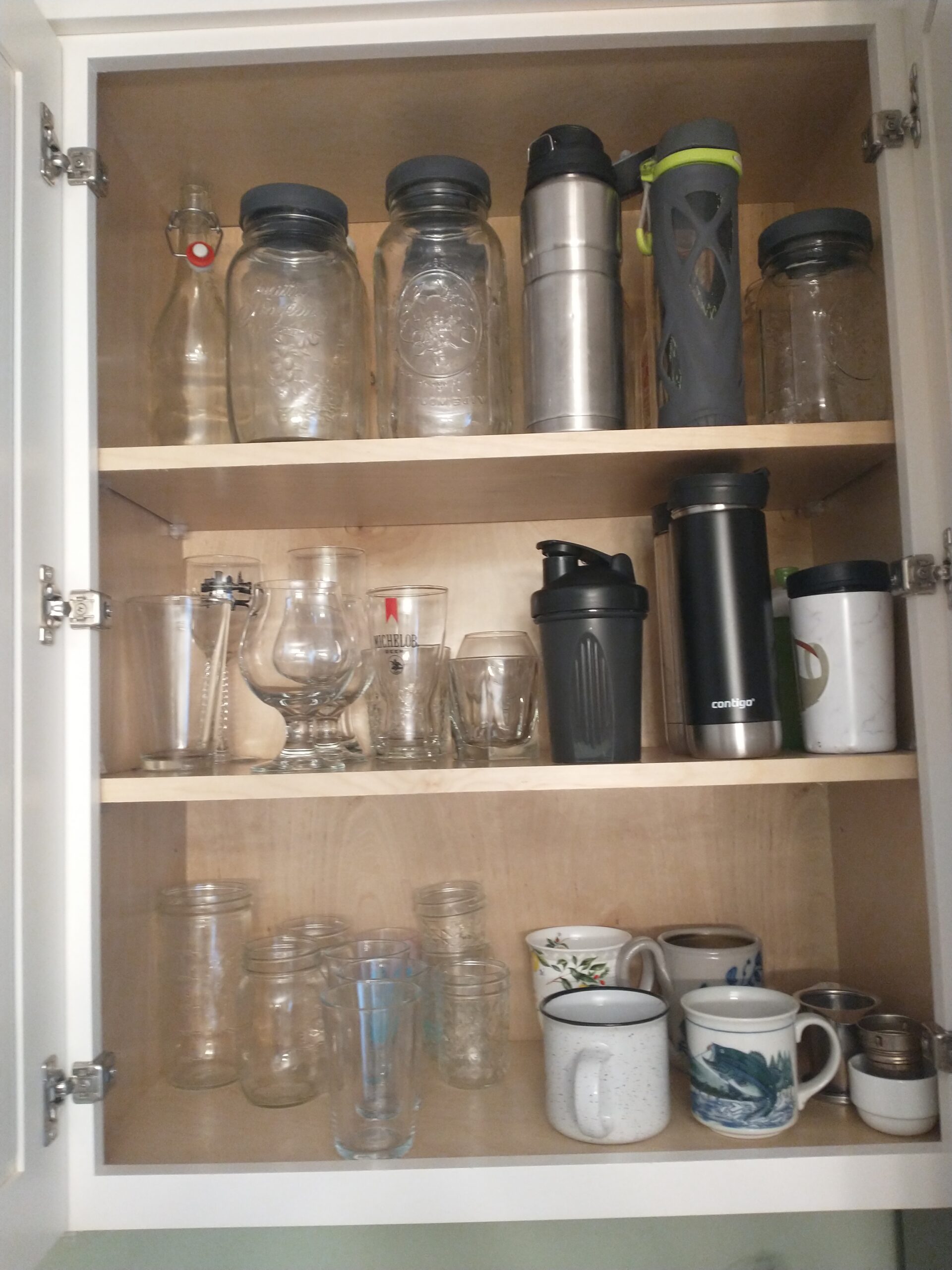
Are you ready to start your realistic kitchen organization?
Are you ready to do your best with what you have? Following these simple steps for realistic kitchen organization will ensure that you are making the best use of your space and prevent you from wasting money and food. Don’t delay, get started now!
FOLLOW ME FOR MORE!
Learn more about me here!
If you need to get consistent with your self care, read here <3
Purchase a kitchen scale (which you probably already have one if you’re baking bread!) here!
If you want to know more about how to track macronutrients to meet your health goals read here!
If you’d like an example of a quick dinner meal we enjoy check this out!
*As an Amazon Associate I earn from qualifying purchases*
